Risk Management Strategies for A-Four Printing's Expansion Plan
VerifiedAdded on 2023/01/12
|31
|11682
|72
Report
AI Summary
This report assesses the risk management strategies for A-Four Printing, an Australian company, as it plans to expand its operations by establishing a new branch in regional Victoria. The report begins by outlining the steps of risk management, including risk identification, analysis, evaluation, treatment, and monitoring. It emphasizes the importance of defining the scope of the risk management process, considering both internal and external environmental factors that could affect the firm. The report identifies and discusses internal and external stakeholders, highlighting their roles in risk identification and mitigation. Furthermore, it addresses the necessity of reviewing different policy contexts and the benefits of evaluating strengths and weaknesses within the organization. The significance of documenting critical success factors and objectives is also explored, alongside the support required for effective risk management activities. The report also touches on the importance of communication with relevant parties, the role of documentation in risk management, and key concerns such as health and safety. The overall aim is to provide a comprehensive overview of risk management considerations for A-Four Printing's expansion project.
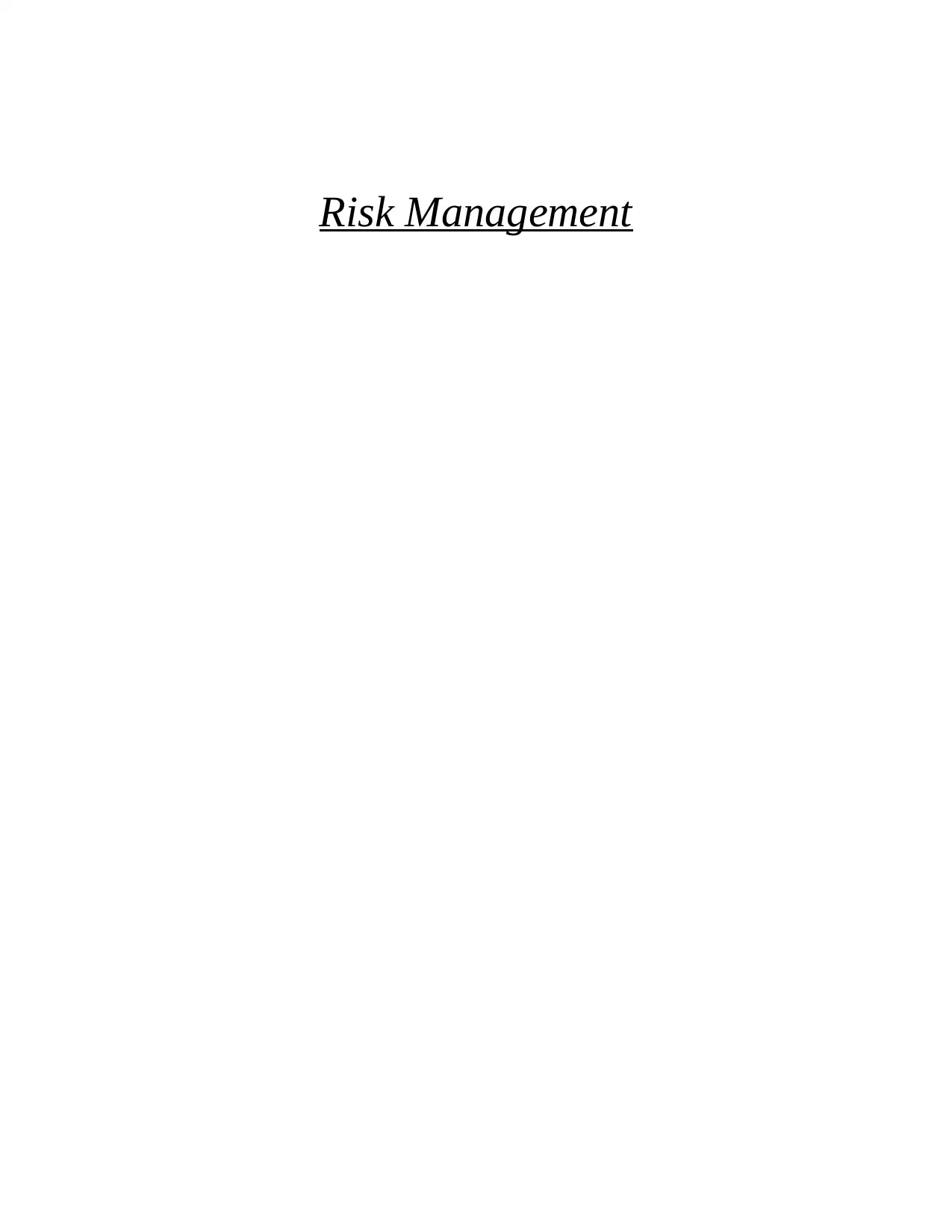
Risk Management
Paraphrase This Document
Need a fresh take? Get an instant paraphrase of this document with our AI Paraphraser
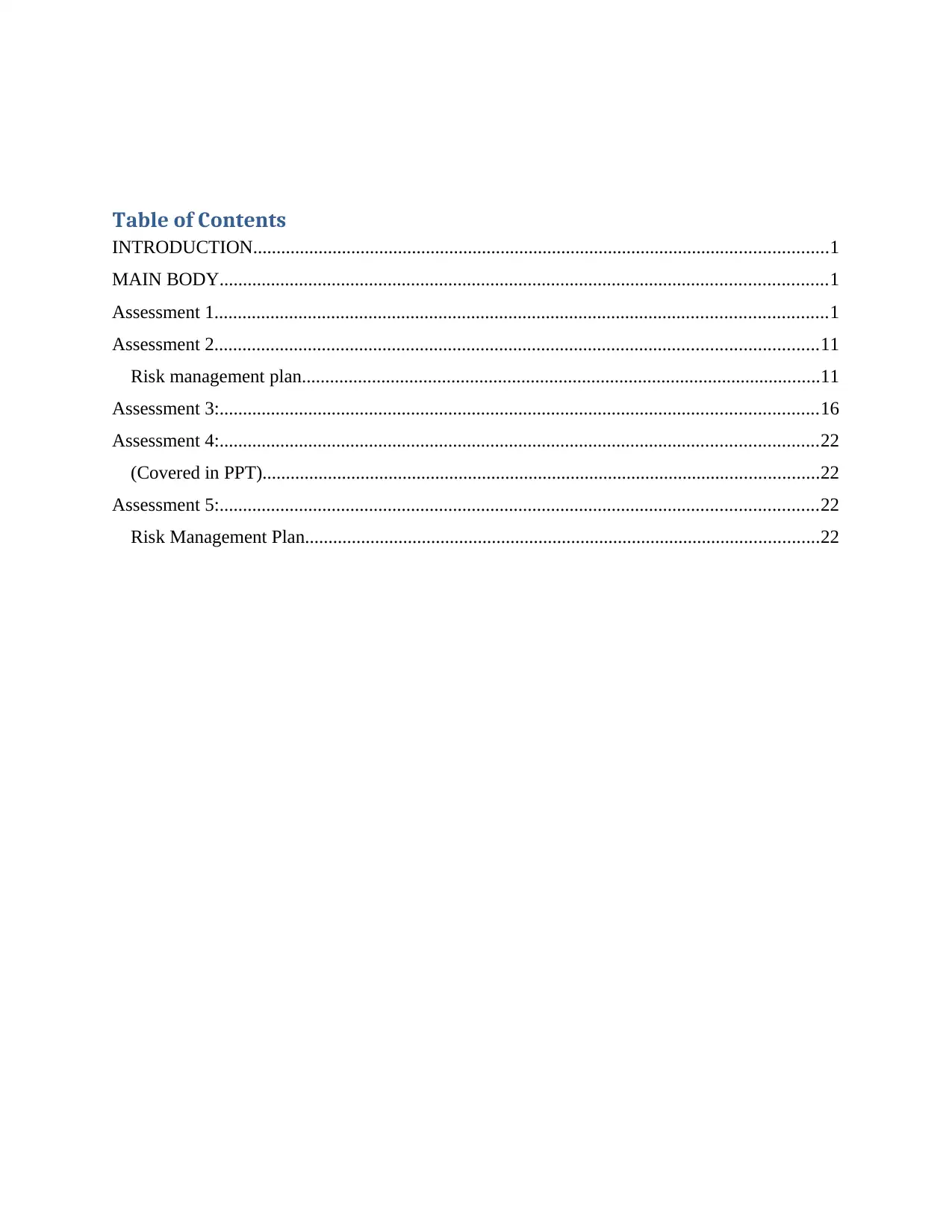
Table of Contents
INTRODUCTION...........................................................................................................................1
MAIN BODY..................................................................................................................................1
Assessment 1...................................................................................................................................1
Assessment 2.................................................................................................................................11
Risk management plan...............................................................................................................11
Assessment 3:................................................................................................................................16
Assessment 4:................................................................................................................................22
(Covered in PPT).......................................................................................................................22
Assessment 5:................................................................................................................................22
Risk Management Plan..............................................................................................................22
INTRODUCTION...........................................................................................................................1
MAIN BODY..................................................................................................................................1
Assessment 1...................................................................................................................................1
Assessment 2.................................................................................................................................11
Risk management plan...............................................................................................................11
Assessment 3:................................................................................................................................16
Assessment 4:................................................................................................................................22
(Covered in PPT).......................................................................................................................22
Assessment 5:................................................................................................................................22
Risk Management Plan..............................................................................................................22

⊘ This is a preview!⊘
Do you want full access?
Subscribe today to unlock all pages.

Trusted by 1+ million students worldwide
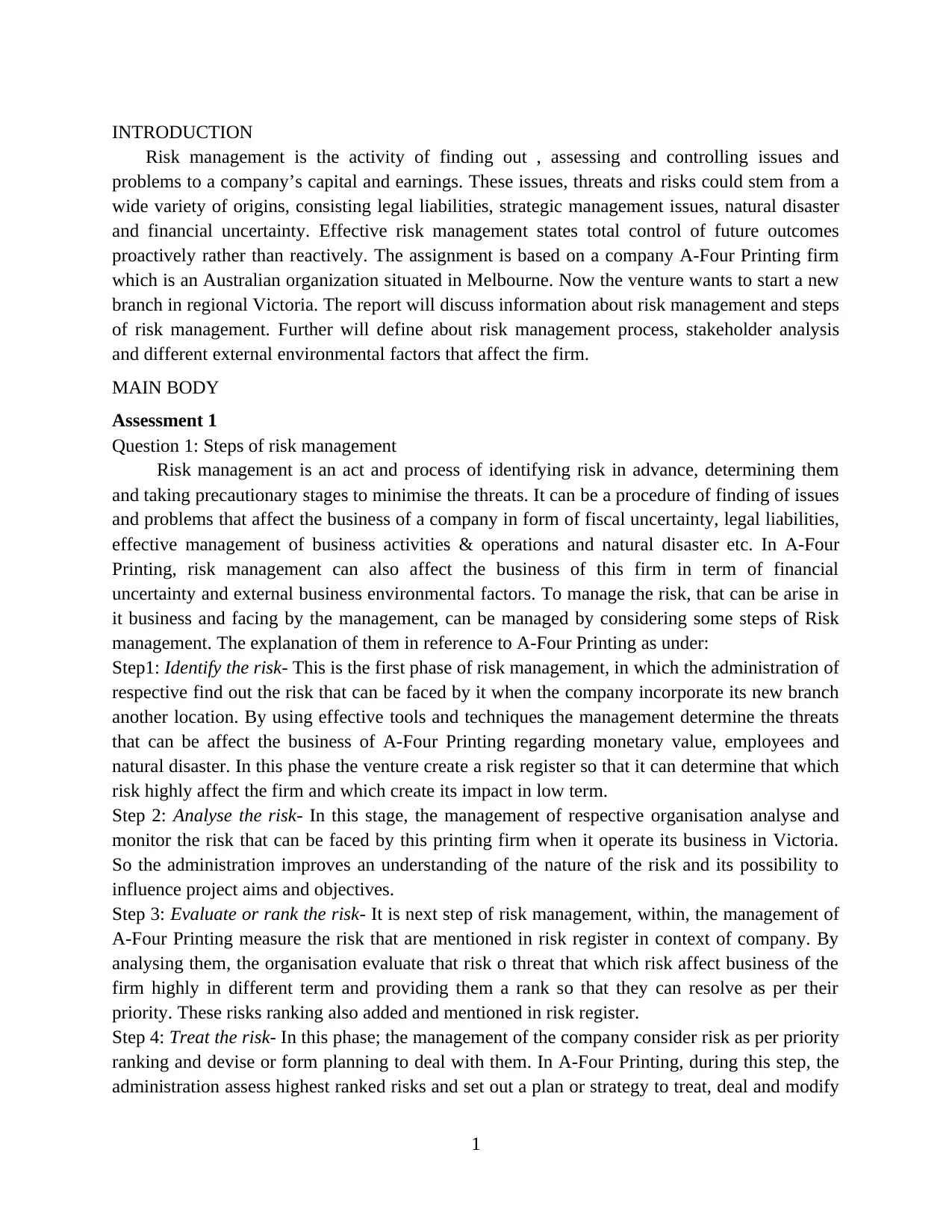
INTRODUCTION
Risk management is the activity of finding out , assessing and controlling issues and
problems to a company’s capital and earnings. These issues, threats and risks could stem from a
wide variety of origins, consisting legal liabilities, strategic management issues, natural disaster
and financial uncertainty. Effective risk management states total control of future outcomes
proactively rather than reactively. The assignment is based on a company A-Four Printing firm
which is an Australian organization situated in Melbourne. Now the venture wants to start a new
branch in regional Victoria. The report will discuss information about risk management and steps
of risk management. Further will define about risk management process, stakeholder analysis
and different external environmental factors that affect the firm.
MAIN BODY
Assessment 1
Question 1: Steps of risk management
Risk management is an act and process of identifying risk in advance, determining them
and taking precautionary stages to minimise the threats. It can be a procedure of finding of issues
and problems that affect the business of a company in form of fiscal uncertainty, legal liabilities,
effective management of business activities & operations and natural disaster etc. In A-Four
Printing, risk management can also affect the business of this firm in term of financial
uncertainty and external business environmental factors. To manage the risk, that can be arise in
it business and facing by the management, can be managed by considering some steps of Risk
management. The explanation of them in reference to A-Four Printing as under:
Step1: Identify the risk- This is the first phase of risk management, in which the administration of
respective find out the risk that can be faced by it when the company incorporate its new branch
another location. By using effective tools and techniques the management determine the threats
that can be affect the business of A-Four Printing regarding monetary value, employees and
natural disaster. In this phase the venture create a risk register so that it can determine that which
risk highly affect the firm and which create its impact in low term.
Step 2: Analyse the risk- In this stage, the management of respective organisation analyse and
monitor the risk that can be faced by this printing firm when it operate its business in Victoria.
So the administration improves an understanding of the nature of the risk and its possibility to
influence project aims and objectives.
Step 3: Evaluate or rank the risk- It is next step of risk management, within, the management of
A-Four Printing measure the risk that are mentioned in risk register in context of company. By
analysing them, the organisation evaluate that risk o threat that which risk affect business of the
firm highly in different term and providing them a rank so that they can resolve as per their
priority. These risks ranking also added and mentioned in risk register.
Step 4: Treat the risk- In this phase; the management of the company consider risk as per priority
ranking and devise or form planning to deal with them. In A-Four Printing, during this step, the
administration assess highest ranked risks and set out a plan or strategy to treat, deal and modify
1
Risk management is the activity of finding out , assessing and controlling issues and
problems to a company’s capital and earnings. These issues, threats and risks could stem from a
wide variety of origins, consisting legal liabilities, strategic management issues, natural disaster
and financial uncertainty. Effective risk management states total control of future outcomes
proactively rather than reactively. The assignment is based on a company A-Four Printing firm
which is an Australian organization situated in Melbourne. Now the venture wants to start a new
branch in regional Victoria. The report will discuss information about risk management and steps
of risk management. Further will define about risk management process, stakeholder analysis
and different external environmental factors that affect the firm.
MAIN BODY
Assessment 1
Question 1: Steps of risk management
Risk management is an act and process of identifying risk in advance, determining them
and taking precautionary stages to minimise the threats. It can be a procedure of finding of issues
and problems that affect the business of a company in form of fiscal uncertainty, legal liabilities,
effective management of business activities & operations and natural disaster etc. In A-Four
Printing, risk management can also affect the business of this firm in term of financial
uncertainty and external business environmental factors. To manage the risk, that can be arise in
it business and facing by the management, can be managed by considering some steps of Risk
management. The explanation of them in reference to A-Four Printing as under:
Step1: Identify the risk- This is the first phase of risk management, in which the administration of
respective find out the risk that can be faced by it when the company incorporate its new branch
another location. By using effective tools and techniques the management determine the threats
that can be affect the business of A-Four Printing regarding monetary value, employees and
natural disaster. In this phase the venture create a risk register so that it can determine that which
risk highly affect the firm and which create its impact in low term.
Step 2: Analyse the risk- In this stage, the management of respective organisation analyse and
monitor the risk that can be faced by this printing firm when it operate its business in Victoria.
So the administration improves an understanding of the nature of the risk and its possibility to
influence project aims and objectives.
Step 3: Evaluate or rank the risk- It is next step of risk management, within, the management of
A-Four Printing measure the risk that are mentioned in risk register in context of company. By
analysing them, the organisation evaluate that risk o threat that which risk affect business of the
firm highly in different term and providing them a rank so that they can resolve as per their
priority. These risks ranking also added and mentioned in risk register.
Step 4: Treat the risk- In this phase; the management of the company consider risk as per priority
ranking and devise or form planning to deal with them. In A-Four Printing, during this step, the
administration assess highest ranked risks and set out a plan or strategy to treat, deal and modify
1
Paraphrase This Document
Need a fresh take? Get an instant paraphrase of this document with our AI Paraphraser
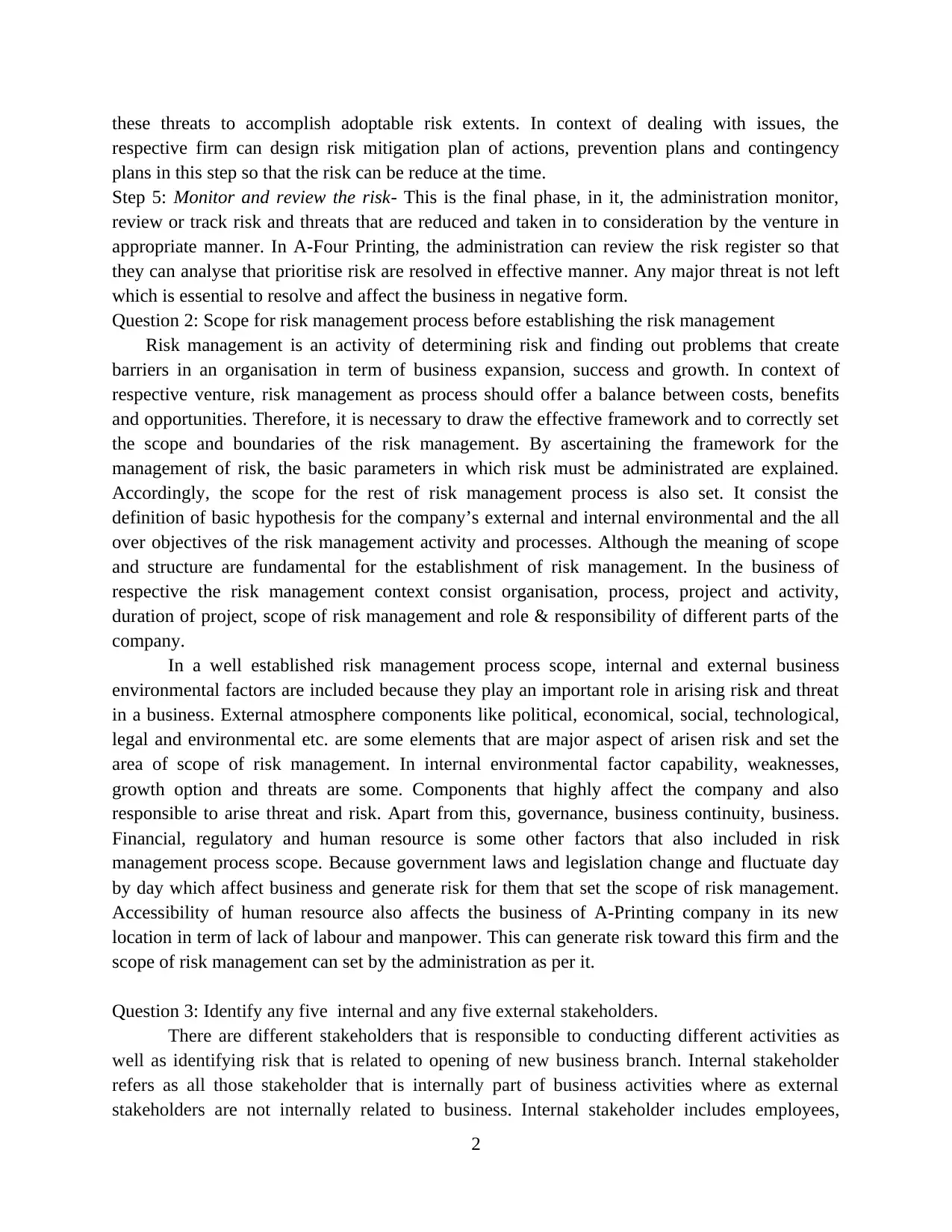
these threats to accomplish adoptable risk extents. In context of dealing with issues, the
respective firm can design risk mitigation plan of actions, prevention plans and contingency
plans in this step so that the risk can be reduce at the time.
Step 5: Monitor and review the risk- This is the final phase, in it, the administration monitor,
review or track risk and threats that are reduced and taken in to consideration by the venture in
appropriate manner. In A-Four Printing, the administration can review the risk register so that
they can analyse that prioritise risk are resolved in effective manner. Any major threat is not left
which is essential to resolve and affect the business in negative form.
Question 2: Scope for risk management process before establishing the risk management
Risk management is an activity of determining risk and finding out problems that create
barriers in an organisation in term of business expansion, success and growth. In context of
respective venture, risk management as process should offer a balance between costs, benefits
and opportunities. Therefore, it is necessary to draw the effective framework and to correctly set
the scope and boundaries of the risk management. By ascertaining the framework for the
management of risk, the basic parameters in which risk must be administrated are explained.
Accordingly, the scope for the rest of risk management process is also set. It consist the
definition of basic hypothesis for the company’s external and internal environmental and the all
over objectives of the risk management activity and processes. Although the meaning of scope
and structure are fundamental for the establishment of risk management. In the business of
respective the risk management context consist organisation, process, project and activity,
duration of project, scope of risk management and role & responsibility of different parts of the
company.
In a well established risk management process scope, internal and external business
environmental factors are included because they play an important role in arising risk and threat
in a business. External atmosphere components like political, economical, social, technological,
legal and environmental etc. are some elements that are major aspect of arisen risk and set the
area of scope of risk management. In internal environmental factor capability, weaknesses,
growth option and threats are some. Components that highly affect the company and also
responsible to arise threat and risk. Apart from this, governance, business continuity, business.
Financial, regulatory and human resource is some other factors that also included in risk
management process scope. Because government laws and legislation change and fluctuate day
by day which affect business and generate risk for them that set the scope of risk management.
Accessibility of human resource also affects the business of A-Printing company in its new
location in term of lack of labour and manpower. This can generate risk toward this firm and the
scope of risk management can set by the administration as per it.
Question 3: Identify any five internal and any five external stakeholders.
There are different stakeholders that is responsible to conducting different activities as
well as identifying risk that is related to opening of new business branch. Internal stakeholder
refers as all those stakeholder that is internally part of business activities where as external
stakeholders are not internally related to business. Internal stakeholder includes employees,
2
respective firm can design risk mitigation plan of actions, prevention plans and contingency
plans in this step so that the risk can be reduce at the time.
Step 5: Monitor and review the risk- This is the final phase, in it, the administration monitor,
review or track risk and threats that are reduced and taken in to consideration by the venture in
appropriate manner. In A-Four Printing, the administration can review the risk register so that
they can analyse that prioritise risk are resolved in effective manner. Any major threat is not left
which is essential to resolve and affect the business in negative form.
Question 2: Scope for risk management process before establishing the risk management
Risk management is an activity of determining risk and finding out problems that create
barriers in an organisation in term of business expansion, success and growth. In context of
respective venture, risk management as process should offer a balance between costs, benefits
and opportunities. Therefore, it is necessary to draw the effective framework and to correctly set
the scope and boundaries of the risk management. By ascertaining the framework for the
management of risk, the basic parameters in which risk must be administrated are explained.
Accordingly, the scope for the rest of risk management process is also set. It consist the
definition of basic hypothesis for the company’s external and internal environmental and the all
over objectives of the risk management activity and processes. Although the meaning of scope
and structure are fundamental for the establishment of risk management. In the business of
respective the risk management context consist organisation, process, project and activity,
duration of project, scope of risk management and role & responsibility of different parts of the
company.
In a well established risk management process scope, internal and external business
environmental factors are included because they play an important role in arising risk and threat
in a business. External atmosphere components like political, economical, social, technological,
legal and environmental etc. are some elements that are major aspect of arisen risk and set the
area of scope of risk management. In internal environmental factor capability, weaknesses,
growth option and threats are some. Components that highly affect the company and also
responsible to arise threat and risk. Apart from this, governance, business continuity, business.
Financial, regulatory and human resource is some other factors that also included in risk
management process scope. Because government laws and legislation change and fluctuate day
by day which affect business and generate risk for them that set the scope of risk management.
Accessibility of human resource also affects the business of A-Printing company in its new
location in term of lack of labour and manpower. This can generate risk toward this firm and the
scope of risk management can set by the administration as per it.
Question 3: Identify any five internal and any five external stakeholders.
There are different stakeholders that is responsible to conducting different activities as
well as identifying risk that is related to opening of new business branch. Internal stakeholder
refers as all those stakeholder that is internally part of business activities where as external
stakeholders are not internally related to business. Internal stakeholder includes employees,
2
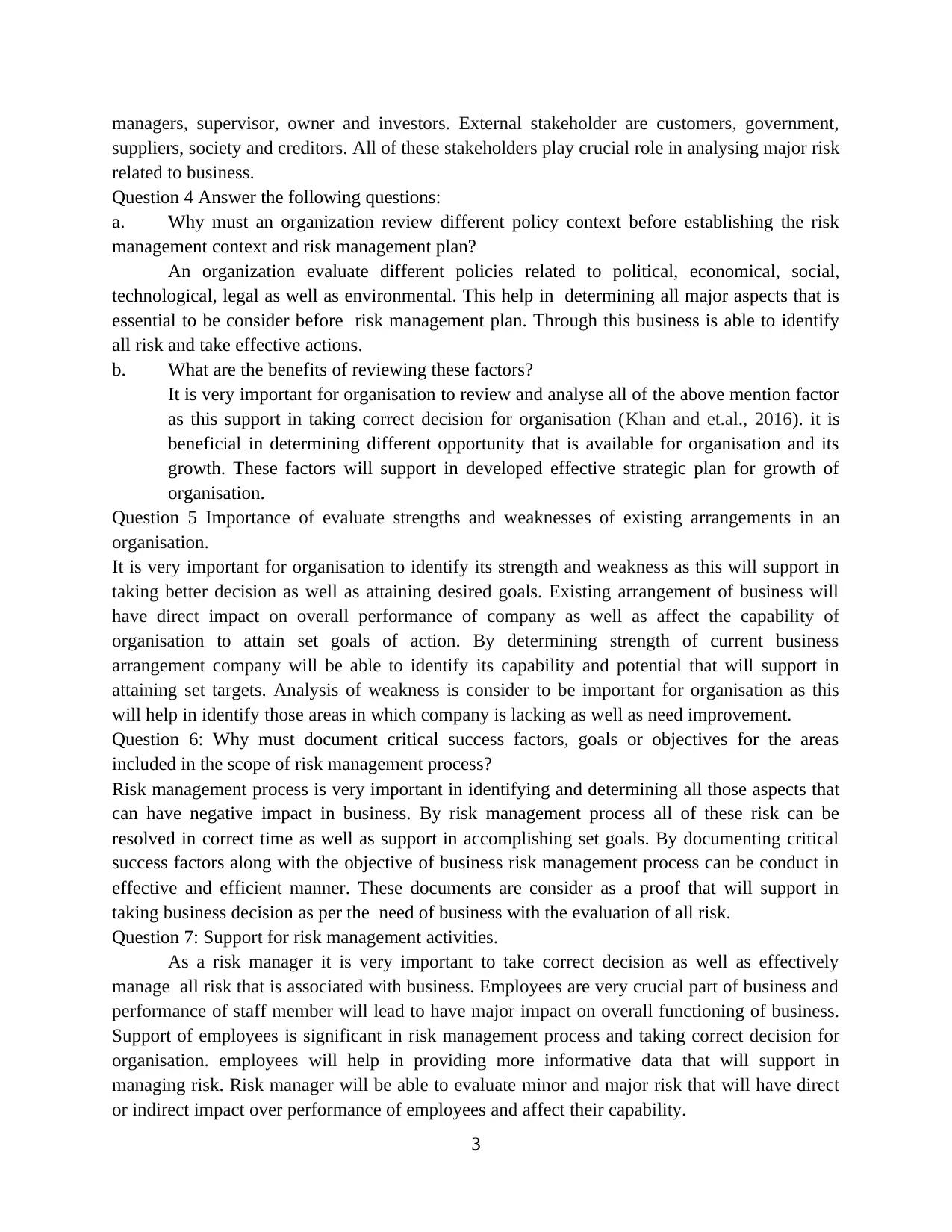
managers, supervisor, owner and investors. External stakeholder are customers, government,
suppliers, society and creditors. All of these stakeholders play crucial role in analysing major risk
related to business.
Question 4 Answer the following questions:
a. Why must an organization review different policy context before establishing the risk
management context and risk management plan?
An organization evaluate different policies related to political, economical, social,
technological, legal as well as environmental. This help in determining all major aspects that is
essential to be consider before risk management plan. Through this business is able to identify
all risk and take effective actions.
b. What are the benefits of reviewing these factors?
It is very important for organisation to review and analyse all of the above mention factor
as this support in taking correct decision for organisation (Khan and et.al., 2016). it is
beneficial in determining different opportunity that is available for organisation and its
growth. These factors will support in developed effective strategic plan for growth of
organisation.
Question 5 Importance of evaluate strengths and weaknesses of existing arrangements in an
organisation.
It is very important for organisation to identify its strength and weakness as this will support in
taking better decision as well as attaining desired goals. Existing arrangement of business will
have direct impact on overall performance of company as well as affect the capability of
organisation to attain set goals of action. By determining strength of current business
arrangement company will be able to identify its capability and potential that will support in
attaining set targets. Analysis of weakness is consider to be important for organisation as this
will help in identify those areas in which company is lacking as well as need improvement.
Question 6: Why must document critical success factors, goals or objectives for the areas
included in the scope of risk management process?
Risk management process is very important in identifying and determining all those aspects that
can have negative impact in business. By risk management process all of these risk can be
resolved in correct time as well as support in accomplishing set goals. By documenting critical
success factors along with the objective of business risk management process can be conduct in
effective and efficient manner. These documents are consider as a proof that will support in
taking business decision as per the need of business with the evaluation of all risk.
Question 7: Support for risk management activities.
As a risk manager it is very important to take correct decision as well as effectively
manage all risk that is associated with business. Employees are very crucial part of business and
performance of staff member will lead to have major impact on overall functioning of business.
Support of employees is significant in risk management process and taking correct decision for
organisation. employees will help in providing more informative data that will support in
managing risk. Risk manager will be able to evaluate minor and major risk that will have direct
or indirect impact over performance of employees and affect their capability.
3
suppliers, society and creditors. All of these stakeholders play crucial role in analysing major risk
related to business.
Question 4 Answer the following questions:
a. Why must an organization review different policy context before establishing the risk
management context and risk management plan?
An organization evaluate different policies related to political, economical, social,
technological, legal as well as environmental. This help in determining all major aspects that is
essential to be consider before risk management plan. Through this business is able to identify
all risk and take effective actions.
b. What are the benefits of reviewing these factors?
It is very important for organisation to review and analyse all of the above mention factor
as this support in taking correct decision for organisation (Khan and et.al., 2016). it is
beneficial in determining different opportunity that is available for organisation and its
growth. These factors will support in developed effective strategic plan for growth of
organisation.
Question 5 Importance of evaluate strengths and weaknesses of existing arrangements in an
organisation.
It is very important for organisation to identify its strength and weakness as this will support in
taking better decision as well as attaining desired goals. Existing arrangement of business will
have direct impact on overall performance of company as well as affect the capability of
organisation to attain set goals of action. By determining strength of current business
arrangement company will be able to identify its capability and potential that will support in
attaining set targets. Analysis of weakness is consider to be important for organisation as this
will help in identify those areas in which company is lacking as well as need improvement.
Question 6: Why must document critical success factors, goals or objectives for the areas
included in the scope of risk management process?
Risk management process is very important in identifying and determining all those aspects that
can have negative impact in business. By risk management process all of these risk can be
resolved in correct time as well as support in accomplishing set goals. By documenting critical
success factors along with the objective of business risk management process can be conduct in
effective and efficient manner. These documents are consider as a proof that will support in
taking business decision as per the need of business with the evaluation of all risk.
Question 7: Support for risk management activities.
As a risk manager it is very important to take correct decision as well as effectively
manage all risk that is associated with business. Employees are very crucial part of business and
performance of staff member will lead to have major impact on overall functioning of business.
Support of employees is significant in risk management process and taking correct decision for
organisation. employees will help in providing more informative data that will support in
managing risk. Risk manager will be able to evaluate minor and major risk that will have direct
or indirect impact over performance of employees and affect their capability.
3
⊘ This is a preview!⊘
Do you want full access?
Subscribe today to unlock all pages.

Trusted by 1+ million students worldwide
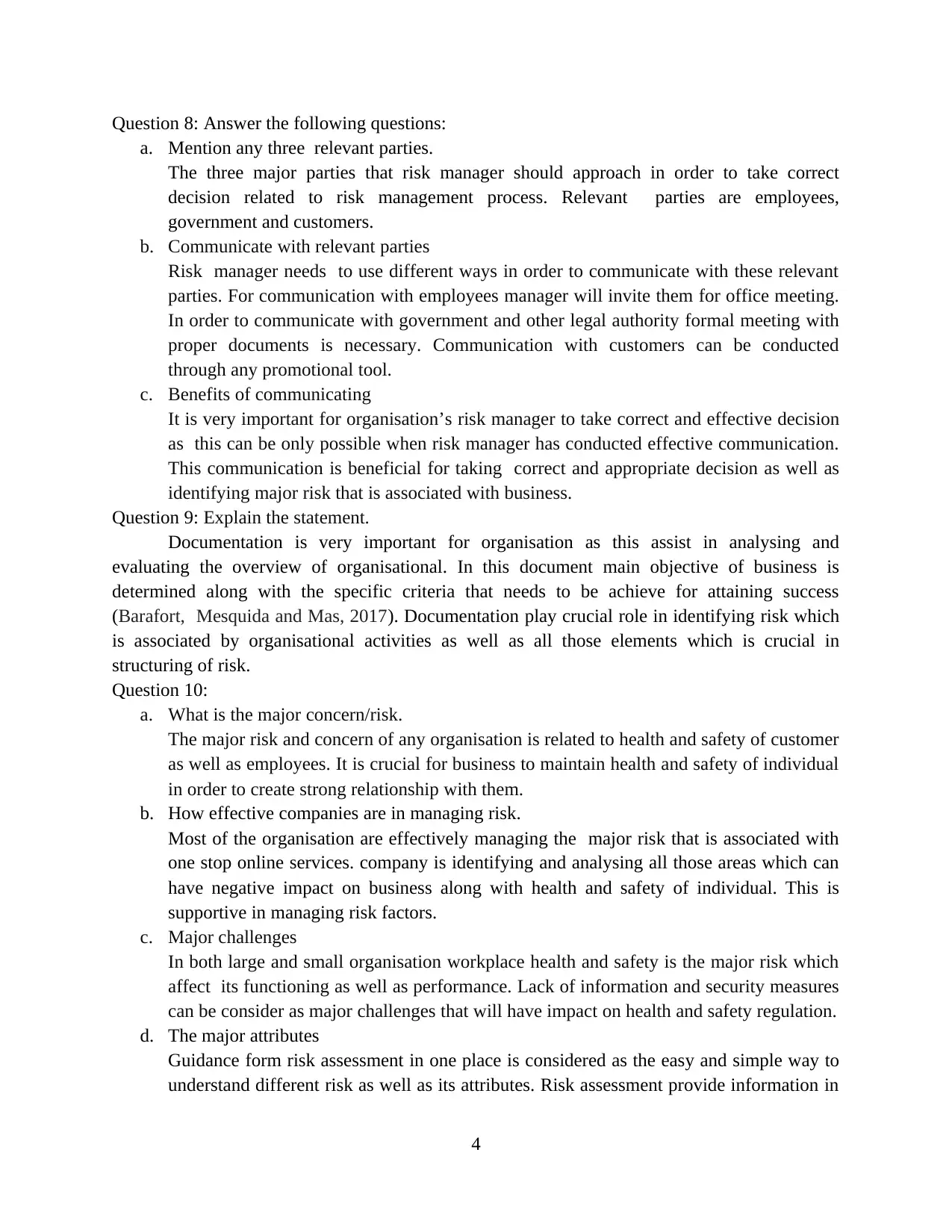
Question 8: Answer the following questions:
a. Mention any three relevant parties.
The three major parties that risk manager should approach in order to take correct
decision related to risk management process. Relevant parties are employees,
government and customers.
b. Communicate with relevant parties
Risk manager needs to use different ways in order to communicate with these relevant
parties. For communication with employees manager will invite them for office meeting.
In order to communicate with government and other legal authority formal meeting with
proper documents is necessary. Communication with customers can be conducted
through any promotional tool.
c. Benefits of communicating
It is very important for organisation’s risk manager to take correct and effective decision
as this can be only possible when risk manager has conducted effective communication.
This communication is beneficial for taking correct and appropriate decision as well as
identifying major risk that is associated with business.
Question 9: Explain the statement.
Documentation is very important for organisation as this assist in analysing and
evaluating the overview of organisational. In this document main objective of business is
determined along with the specific criteria that needs to be achieve for attaining success
(Barafort, Mesquida and Mas, 2017). Documentation play crucial role in identifying risk which
is associated by organisational activities as well as all those elements which is crucial in
structuring of risk.
Question 10:
a. What is the major concern/risk.
The major risk and concern of any organisation is related to health and safety of customer
as well as employees. It is crucial for business to maintain health and safety of individual
in order to create strong relationship with them.
b. How effective companies are in managing risk.
Most of the organisation are effectively managing the major risk that is associated with
one stop online services. company is identifying and analysing all those areas which can
have negative impact on business along with health and safety of individual. This is
supportive in managing risk factors.
c. Major challenges
In both large and small organisation workplace health and safety is the major risk which
affect its functioning as well as performance. Lack of information and security measures
can be consider as major challenges that will have impact on health and safety regulation.
d. The major attributes
Guidance form risk assessment in one place is considered as the easy and simple way to
understand different risk as well as its attributes. Risk assessment provide information in
4
a. Mention any three relevant parties.
The three major parties that risk manager should approach in order to take correct
decision related to risk management process. Relevant parties are employees,
government and customers.
b. Communicate with relevant parties
Risk manager needs to use different ways in order to communicate with these relevant
parties. For communication with employees manager will invite them for office meeting.
In order to communicate with government and other legal authority formal meeting with
proper documents is necessary. Communication with customers can be conducted
through any promotional tool.
c. Benefits of communicating
It is very important for organisation’s risk manager to take correct and effective decision
as this can be only possible when risk manager has conducted effective communication.
This communication is beneficial for taking correct and appropriate decision as well as
identifying major risk that is associated with business.
Question 9: Explain the statement.
Documentation is very important for organisation as this assist in analysing and
evaluating the overview of organisational. In this document main objective of business is
determined along with the specific criteria that needs to be achieve for attaining success
(Barafort, Mesquida and Mas, 2017). Documentation play crucial role in identifying risk which
is associated by organisational activities as well as all those elements which is crucial in
structuring of risk.
Question 10:
a. What is the major concern/risk.
The major risk and concern of any organisation is related to health and safety of customer
as well as employees. It is crucial for business to maintain health and safety of individual
in order to create strong relationship with them.
b. How effective companies are in managing risk.
Most of the organisation are effectively managing the major risk that is associated with
one stop online services. company is identifying and analysing all those areas which can
have negative impact on business along with health and safety of individual. This is
supportive in managing risk factors.
c. Major challenges
In both large and small organisation workplace health and safety is the major risk which
affect its functioning as well as performance. Lack of information and security measures
can be consider as major challenges that will have impact on health and safety regulation.
d. The major attributes
Guidance form risk assessment in one place is considered as the easy and simple way to
understand different risk as well as its attributes. Risk assessment provide information in
4
Paraphrase This Document
Need a fresh take? Get an instant paraphrase of this document with our AI Paraphraser
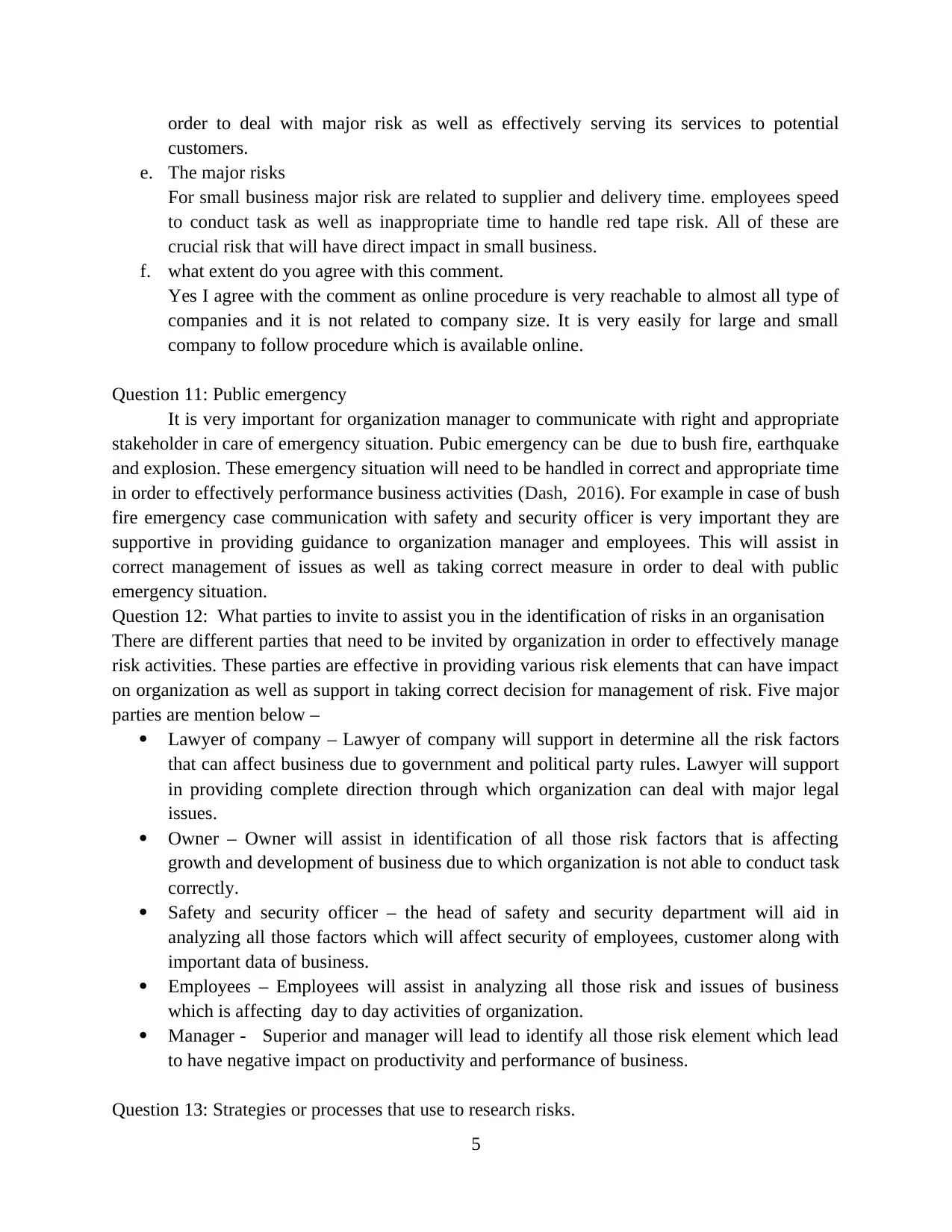
order to deal with major risk as well as effectively serving its services to potential
customers.
e. The major risks
For small business major risk are related to supplier and delivery time. employees speed
to conduct task as well as inappropriate time to handle red tape risk. All of these are
crucial risk that will have direct impact in small business.
f. what extent do you agree with this comment.
Yes I agree with the comment as online procedure is very reachable to almost all type of
companies and it is not related to company size. It is very easily for large and small
company to follow procedure which is available online.
Question 11: Public emergency
It is very important for organization manager to communicate with right and appropriate
stakeholder in care of emergency situation. Pubic emergency can be due to bush fire, earthquake
and explosion. These emergency situation will need to be handled in correct and appropriate time
in order to effectively performance business activities (Dash, 2016). For example in case of bush
fire emergency case communication with safety and security officer is very important they are
supportive in providing guidance to organization manager and employees. This will assist in
correct management of issues as well as taking correct measure in order to deal with public
emergency situation.
Question 12: What parties to invite to assist you in the identification of risks in an organisation
There are different parties that need to be invited by organization in order to effectively manage
risk activities. These parties are effective in providing various risk elements that can have impact
on organization as well as support in taking correct decision for management of risk. Five major
parties are mention below –
Lawyer of company – Lawyer of company will support in determine all the risk factors
that can affect business due to government and political party rules. Lawyer will support
in providing complete direction through which organization can deal with major legal
issues.
Owner – Owner will assist in identification of all those risk factors that is affecting
growth and development of business due to which organization is not able to conduct task
correctly.
Safety and security officer – the head of safety and security department will aid in
analyzing all those factors which will affect security of employees, customer along with
important data of business.
Employees – Employees will assist in analyzing all those risk and issues of business
which is affecting day to day activities of organization.
Manager - Superior and manager will lead to identify all those risk element which lead
to have negative impact on productivity and performance of business.
Question 13: Strategies or processes that use to research risks.
5
customers.
e. The major risks
For small business major risk are related to supplier and delivery time. employees speed
to conduct task as well as inappropriate time to handle red tape risk. All of these are
crucial risk that will have direct impact in small business.
f. what extent do you agree with this comment.
Yes I agree with the comment as online procedure is very reachable to almost all type of
companies and it is not related to company size. It is very easily for large and small
company to follow procedure which is available online.
Question 11: Public emergency
It is very important for organization manager to communicate with right and appropriate
stakeholder in care of emergency situation. Pubic emergency can be due to bush fire, earthquake
and explosion. These emergency situation will need to be handled in correct and appropriate time
in order to effectively performance business activities (Dash, 2016). For example in case of bush
fire emergency case communication with safety and security officer is very important they are
supportive in providing guidance to organization manager and employees. This will assist in
correct management of issues as well as taking correct measure in order to deal with public
emergency situation.
Question 12: What parties to invite to assist you in the identification of risks in an organisation
There are different parties that need to be invited by organization in order to effectively manage
risk activities. These parties are effective in providing various risk elements that can have impact
on organization as well as support in taking correct decision for management of risk. Five major
parties are mention below –
Lawyer of company – Lawyer of company will support in determine all the risk factors
that can affect business due to government and political party rules. Lawyer will support
in providing complete direction through which organization can deal with major legal
issues.
Owner – Owner will assist in identification of all those risk factors that is affecting
growth and development of business due to which organization is not able to conduct task
correctly.
Safety and security officer – the head of safety and security department will aid in
analyzing all those factors which will affect security of employees, customer along with
important data of business.
Employees – Employees will assist in analyzing all those risk and issues of business
which is affecting day to day activities of organization.
Manager - Superior and manager will lead to identify all those risk element which lead
to have negative impact on productivity and performance of business.
Question 13: Strategies or processes that use to research risks.
5
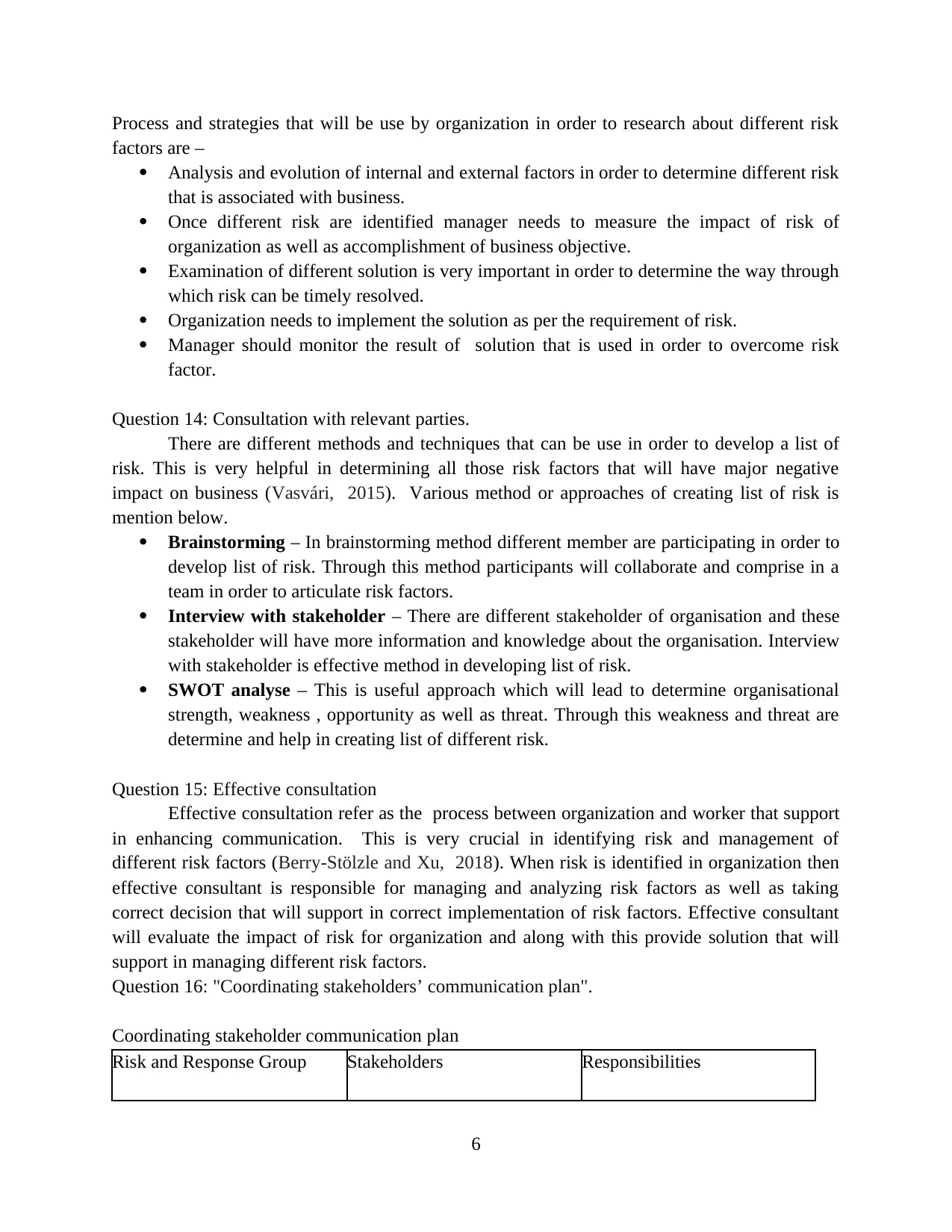
Process and strategies that will be use by organization in order to research about different risk
factors are –
Analysis and evolution of internal and external factors in order to determine different risk
that is associated with business.
Once different risk are identified manager needs to measure the impact of risk of
organization as well as accomplishment of business objective.
Examination of different solution is very important in order to determine the way through
which risk can be timely resolved.
Organization needs to implement the solution as per the requirement of risk.
Manager should monitor the result of solution that is used in order to overcome risk
factor.
Question 14: Consultation with relevant parties.
There are different methods and techniques that can be use in order to develop a list of
risk. This is very helpful in determining all those risk factors that will have major negative
impact on business (Vasvári, 2015). Various method or approaches of creating list of risk is
mention below.
Brainstorming – In brainstorming method different member are participating in order to
develop list of risk. Through this method participants will collaborate and comprise in a
team in order to articulate risk factors.
Interview with stakeholder – There are different stakeholder of organisation and these
stakeholder will have more information and knowledge about the organisation. Interview
with stakeholder is effective method in developing list of risk.
SWOT analyse – This is useful approach which will lead to determine organisational
strength, weakness , opportunity as well as threat. Through this weakness and threat are
determine and help in creating list of different risk.
Question 15: Effective consultation
Effective consultation refer as the process between organization and worker that support
in enhancing communication. This is very crucial in identifying risk and management of
different risk factors (Berry‐Stölzle and Xu, 2018). When risk is identified in organization then
effective consultant is responsible for managing and analyzing risk factors as well as taking
correct decision that will support in correct implementation of risk factors. Effective consultant
will evaluate the impact of risk for organization and along with this provide solution that will
support in managing different risk factors.
Question 16: "Coordinating stakeholders’ communication plan".
Coordinating stakeholder communication plan
Risk and Response Group Stakeholders Responsibilities
6
factors are –
Analysis and evolution of internal and external factors in order to determine different risk
that is associated with business.
Once different risk are identified manager needs to measure the impact of risk of
organization as well as accomplishment of business objective.
Examination of different solution is very important in order to determine the way through
which risk can be timely resolved.
Organization needs to implement the solution as per the requirement of risk.
Manager should monitor the result of solution that is used in order to overcome risk
factor.
Question 14: Consultation with relevant parties.
There are different methods and techniques that can be use in order to develop a list of
risk. This is very helpful in determining all those risk factors that will have major negative
impact on business (Vasvári, 2015). Various method or approaches of creating list of risk is
mention below.
Brainstorming – In brainstorming method different member are participating in order to
develop list of risk. Through this method participants will collaborate and comprise in a
team in order to articulate risk factors.
Interview with stakeholder – There are different stakeholder of organisation and these
stakeholder will have more information and knowledge about the organisation. Interview
with stakeholder is effective method in developing list of risk.
SWOT analyse – This is useful approach which will lead to determine organisational
strength, weakness , opportunity as well as threat. Through this weakness and threat are
determine and help in creating list of different risk.
Question 15: Effective consultation
Effective consultation refer as the process between organization and worker that support
in enhancing communication. This is very crucial in identifying risk and management of
different risk factors (Berry‐Stölzle and Xu, 2018). When risk is identified in organization then
effective consultant is responsible for managing and analyzing risk factors as well as taking
correct decision that will support in correct implementation of risk factors. Effective consultant
will evaluate the impact of risk for organization and along with this provide solution that will
support in managing different risk factors.
Question 16: "Coordinating stakeholders’ communication plan".
Coordinating stakeholder communication plan
Risk and Response Group Stakeholders Responsibilities
6
⊘ This is a preview!⊘
Do you want full access?
Subscribe today to unlock all pages.

Trusted by 1+ million students worldwide
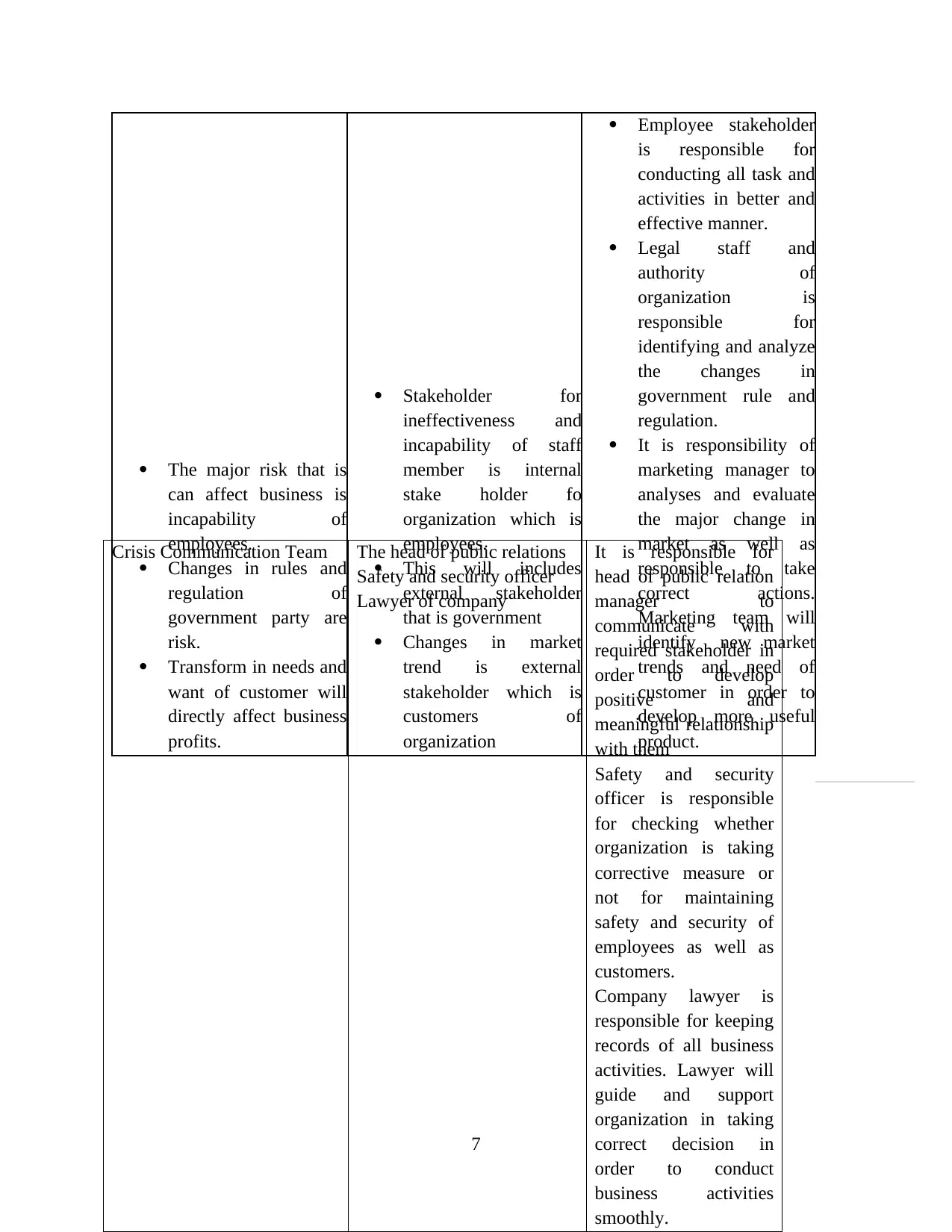
The major risk that is
can affect business is
incapability of
employees.
Changes in rules and
regulation of
government party are
risk.
Transform in needs and
want of customer will
directly affect business
profits.
Stakeholder for
ineffectiveness and
incapability of staff
member is internal
stake holder fo
organization which is
employees.
This will includes
external stakeholder
that is government
Changes in market
trend is external
stakeholder which is
customers of
organization
Employee stakeholder
is responsible for
conducting all task and
activities in better and
effective manner.
Legal staff and
authority of
organization is
responsible for
identifying and analyze
the changes in
government rule and
regulation.
It is responsibility of
marketing manager to
analyses and evaluate
the major change in
market as well as
responsible to take
correct actions.
Marketing team will
identify new market
trends and need of
customer in order to
develop more useful
product.
7
Crisis Communication Team The head of public relations
Safety and security officer
Lawyer of company
It is responsible for
head of public relation
manager to
communicate with
required stakeholder in
order to develop
positive and
meaningful relationship
with them
Safety and security
officer is responsible
for checking whether
organization is taking
corrective measure or
not for maintaining
safety and security of
employees as well as
customers.
Company lawyer is
responsible for keeping
records of all business
activities. Lawyer will
guide and support
organization in taking
correct decision in
order to conduct
business activities
smoothly.
can affect business is
incapability of
employees.
Changes in rules and
regulation of
government party are
risk.
Transform in needs and
want of customer will
directly affect business
profits.
Stakeholder for
ineffectiveness and
incapability of staff
member is internal
stake holder fo
organization which is
employees.
This will includes
external stakeholder
that is government
Changes in market
trend is external
stakeholder which is
customers of
organization
Employee stakeholder
is responsible for
conducting all task and
activities in better and
effective manner.
Legal staff and
authority of
organization is
responsible for
identifying and analyze
the changes in
government rule and
regulation.
It is responsibility of
marketing manager to
analyses and evaluate
the major change in
market as well as
responsible to take
correct actions.
Marketing team will
identify new market
trends and need of
customer in order to
develop more useful
product.
7
Crisis Communication Team The head of public relations
Safety and security officer
Lawyer of company
It is responsible for
head of public relation
manager to
communicate with
required stakeholder in
order to develop
positive and
meaningful relationship
with them
Safety and security
officer is responsible
for checking whether
organization is taking
corrective measure or
not for maintaining
safety and security of
employees as well as
customers.
Company lawyer is
responsible for keeping
records of all business
activities. Lawyer will
guide and support
organization in taking
correct decision in
order to conduct
business activities
smoothly.
Paraphrase This Document
Need a fresh take? Get an instant paraphrase of this document with our AI Paraphraser
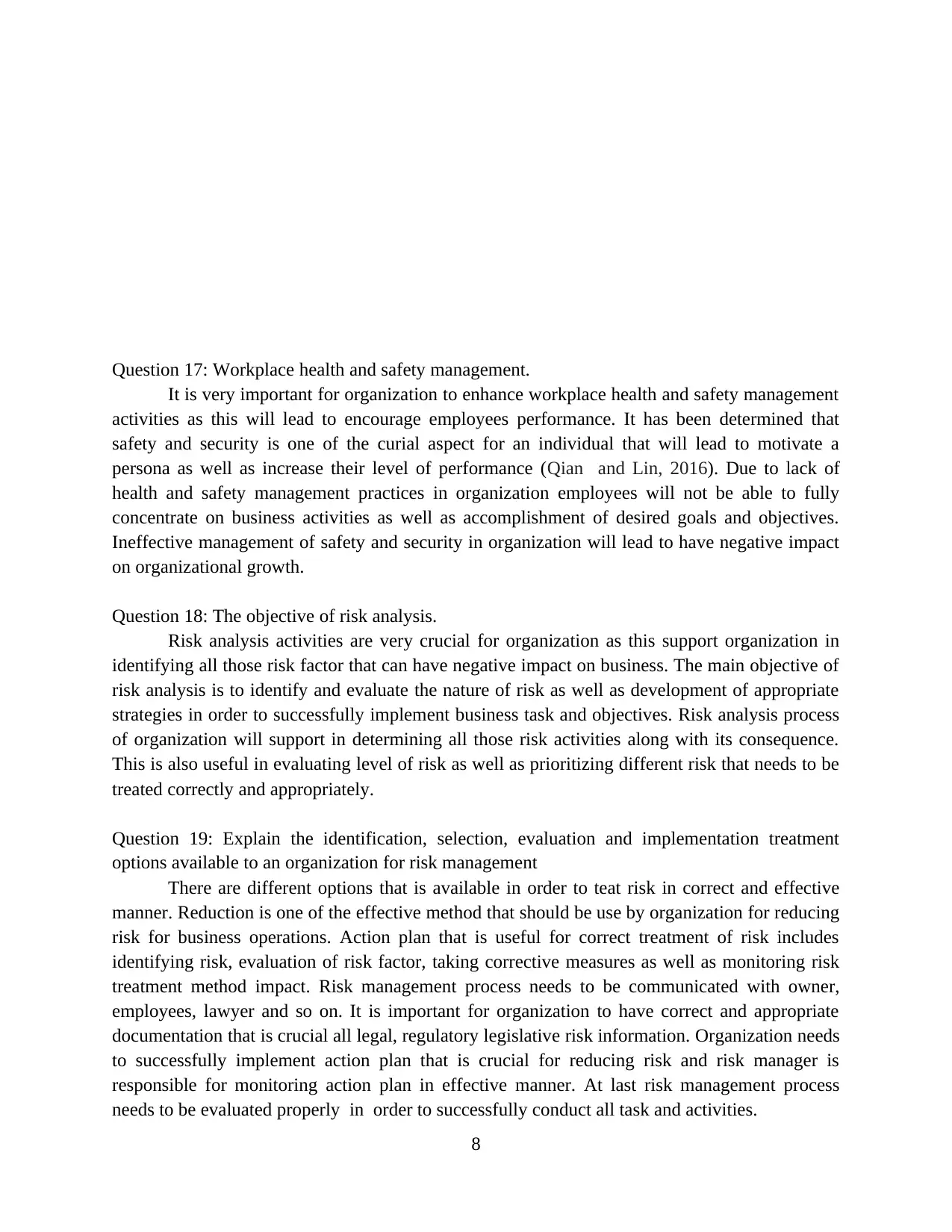
Question 17: Workplace health and safety management.
It is very important for organization to enhance workplace health and safety management
activities as this will lead to encourage employees performance. It has been determined that
safety and security is one of the curial aspect for an individual that will lead to motivate a
persona as well as increase their level of performance (Qian and Lin, 2016). Due to lack of
health and safety management practices in organization employees will not be able to fully
concentrate on business activities as well as accomplishment of desired goals and objectives.
Ineffective management of safety and security in organization will lead to have negative impact
on organizational growth.
Question 18: The objective of risk analysis.
Risk analysis activities are very crucial for organization as this support organization in
identifying all those risk factor that can have negative impact on business. The main objective of
risk analysis is to identify and evaluate the nature of risk as well as development of appropriate
strategies in order to successfully implement business task and objectives. Risk analysis process
of organization will support in determining all those risk activities along with its consequence.
This is also useful in evaluating level of risk as well as prioritizing different risk that needs to be
treated correctly and appropriately.
Question 19: Explain the identification, selection, evaluation and implementation treatment
options available to an organization for risk management
There are different options that is available in order to teat risk in correct and effective
manner. Reduction is one of the effective method that should be use by organization for reducing
risk for business operations. Action plan that is useful for correct treatment of risk includes
identifying risk, evaluation of risk factor, taking corrective measures as well as monitoring risk
treatment method impact. Risk management process needs to be communicated with owner,
employees, lawyer and so on. It is important for organization to have correct and appropriate
documentation that is crucial all legal, regulatory legislative risk information. Organization needs
to successfully implement action plan that is crucial for reducing risk and risk manager is
responsible for monitoring action plan in effective manner. At last risk management process
needs to be evaluated properly in order to successfully conduct all task and activities.
8
It is very important for organization to enhance workplace health and safety management
activities as this will lead to encourage employees performance. It has been determined that
safety and security is one of the curial aspect for an individual that will lead to motivate a
persona as well as increase their level of performance (Qian and Lin, 2016). Due to lack of
health and safety management practices in organization employees will not be able to fully
concentrate on business activities as well as accomplishment of desired goals and objectives.
Ineffective management of safety and security in organization will lead to have negative impact
on organizational growth.
Question 18: The objective of risk analysis.
Risk analysis activities are very crucial for organization as this support organization in
identifying all those risk factor that can have negative impact on business. The main objective of
risk analysis is to identify and evaluate the nature of risk as well as development of appropriate
strategies in order to successfully implement business task and objectives. Risk analysis process
of organization will support in determining all those risk activities along with its consequence.
This is also useful in evaluating level of risk as well as prioritizing different risk that needs to be
treated correctly and appropriately.
Question 19: Explain the identification, selection, evaluation and implementation treatment
options available to an organization for risk management
There are different options that is available in order to teat risk in correct and effective
manner. Reduction is one of the effective method that should be use by organization for reducing
risk for business operations. Action plan that is useful for correct treatment of risk includes
identifying risk, evaluation of risk factor, taking corrective measures as well as monitoring risk
treatment method impact. Risk management process needs to be communicated with owner,
employees, lawyer and so on. It is important for organization to have correct and appropriate
documentation that is crucial all legal, regulatory legislative risk information. Organization needs
to successfully implement action plan that is crucial for reducing risk and risk manager is
responsible for monitoring action plan in effective manner. At last risk management process
needs to be evaluated properly in order to successfully conduct all task and activities.
8
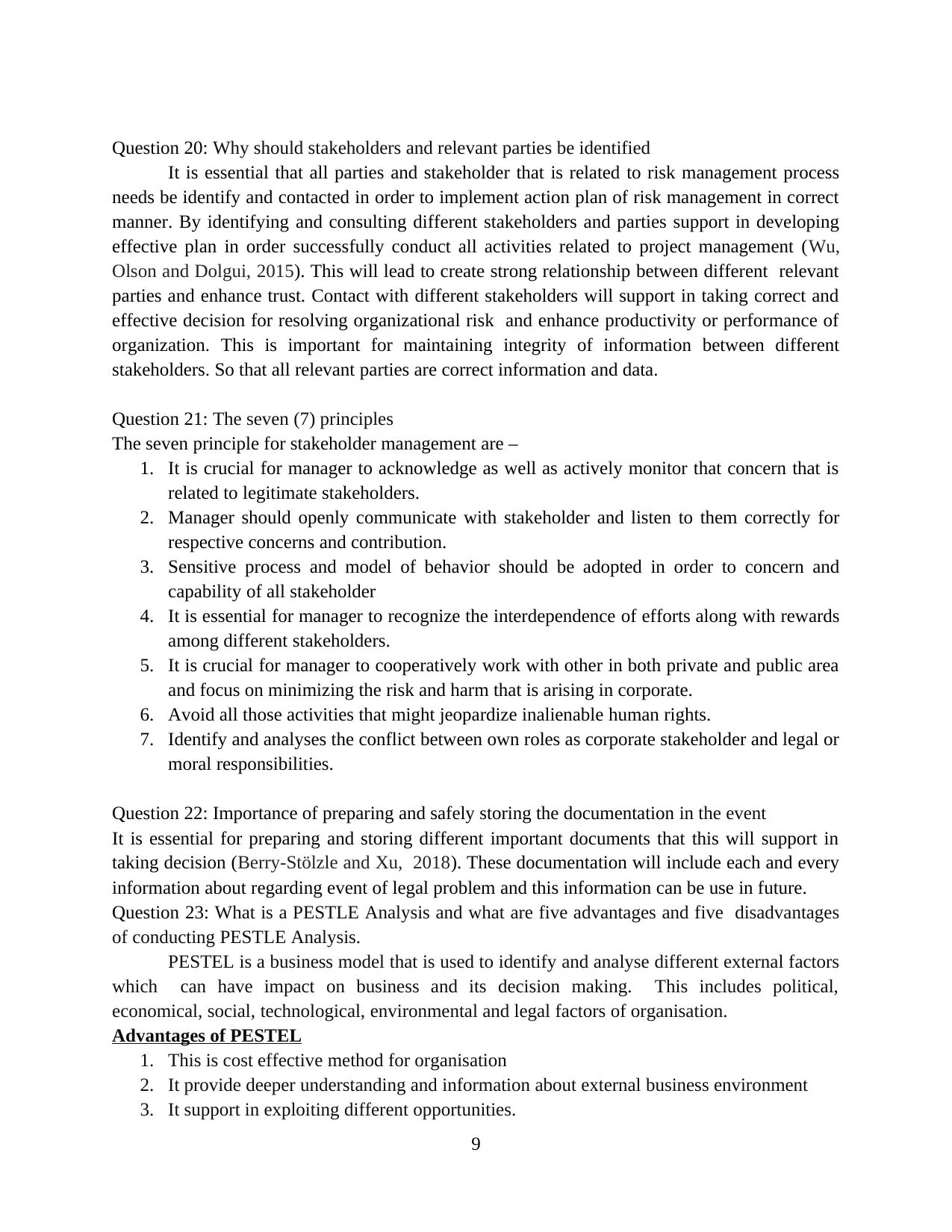
Question 20: Why should stakeholders and relevant parties be identified
It is essential that all parties and stakeholder that is related to risk management process
needs be identify and contacted in order to implement action plan of risk management in correct
manner. By identifying and consulting different stakeholders and parties support in developing
effective plan in order successfully conduct all activities related to project management (Wu,
Olson and Dolgui, 2015). This will lead to create strong relationship between different relevant
parties and enhance trust. Contact with different stakeholders will support in taking correct and
effective decision for resolving organizational risk and enhance productivity or performance of
organization. This is important for maintaining integrity of information between different
stakeholders. So that all relevant parties are correct information and data.
Question 21: The seven (7) principles
The seven principle for stakeholder management are –
1. It is crucial for manager to acknowledge as well as actively monitor that concern that is
related to legitimate stakeholders.
2. Manager should openly communicate with stakeholder and listen to them correctly for
respective concerns and contribution.
3. Sensitive process and model of behavior should be adopted in order to concern and
capability of all stakeholder
4. It is essential for manager to recognize the interdependence of efforts along with rewards
among different stakeholders.
5. It is crucial for manager to cooperatively work with other in both private and public area
and focus on minimizing the risk and harm that is arising in corporate.
6. Avoid all those activities that might jeopardize inalienable human rights.
7. Identify and analyses the conflict between own roles as corporate stakeholder and legal or
moral responsibilities.
Question 22: Importance of preparing and safely storing the documentation in the event
It is essential for preparing and storing different important documents that this will support in
taking decision (Berry‐Stölzle and Xu, 2018). These documentation will include each and every
information about regarding event of legal problem and this information can be use in future.
Question 23: What is a PESTLE Analysis and what are five advantages and five disadvantages
of conducting PESTLE Analysis.
PESTEL is a business model that is used to identify and analyse different external factors
which can have impact on business and its decision making. This includes political,
economical, social, technological, environmental and legal factors of organisation.
Advantages of PESTEL
1. This is cost effective method for organisation
2. It provide deeper understanding and information about external business environment
3. It support in exploiting different opportunities.
9
It is essential that all parties and stakeholder that is related to risk management process
needs be identify and contacted in order to implement action plan of risk management in correct
manner. By identifying and consulting different stakeholders and parties support in developing
effective plan in order successfully conduct all activities related to project management (Wu,
Olson and Dolgui, 2015). This will lead to create strong relationship between different relevant
parties and enhance trust. Contact with different stakeholders will support in taking correct and
effective decision for resolving organizational risk and enhance productivity or performance of
organization. This is important for maintaining integrity of information between different
stakeholders. So that all relevant parties are correct information and data.
Question 21: The seven (7) principles
The seven principle for stakeholder management are –
1. It is crucial for manager to acknowledge as well as actively monitor that concern that is
related to legitimate stakeholders.
2. Manager should openly communicate with stakeholder and listen to them correctly for
respective concerns and contribution.
3. Sensitive process and model of behavior should be adopted in order to concern and
capability of all stakeholder
4. It is essential for manager to recognize the interdependence of efforts along with rewards
among different stakeholders.
5. It is crucial for manager to cooperatively work with other in both private and public area
and focus on minimizing the risk and harm that is arising in corporate.
6. Avoid all those activities that might jeopardize inalienable human rights.
7. Identify and analyses the conflict between own roles as corporate stakeholder and legal or
moral responsibilities.
Question 22: Importance of preparing and safely storing the documentation in the event
It is essential for preparing and storing different important documents that this will support in
taking decision (Berry‐Stölzle and Xu, 2018). These documentation will include each and every
information about regarding event of legal problem and this information can be use in future.
Question 23: What is a PESTLE Analysis and what are five advantages and five disadvantages
of conducting PESTLE Analysis.
PESTEL is a business model that is used to identify and analyse different external factors
which can have impact on business and its decision making. This includes political,
economical, social, technological, environmental and legal factors of organisation.
Advantages of PESTEL
1. This is cost effective method for organisation
2. It provide deeper understanding and information about external business environment
3. It support in exploiting different opportunities.
9
⊘ This is a preview!⊘
Do you want full access?
Subscribe today to unlock all pages.

Trusted by 1+ million students worldwide
1 out of 31
Related Documents
Your All-in-One AI-Powered Toolkit for Academic Success.
+13062052269
info@desklib.com
Available 24*7 on WhatsApp / Email
![[object Object]](/_next/static/media/star-bottom.7253800d.svg)
Unlock your academic potential
Copyright © 2020–2025 A2Z Services. All Rights Reserved. Developed and managed by ZUCOL.





